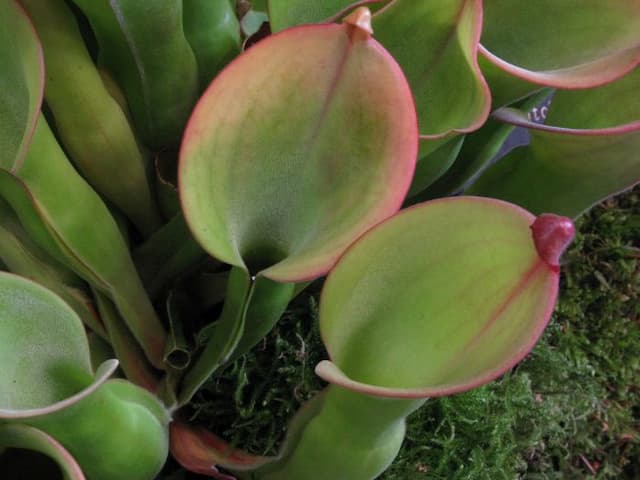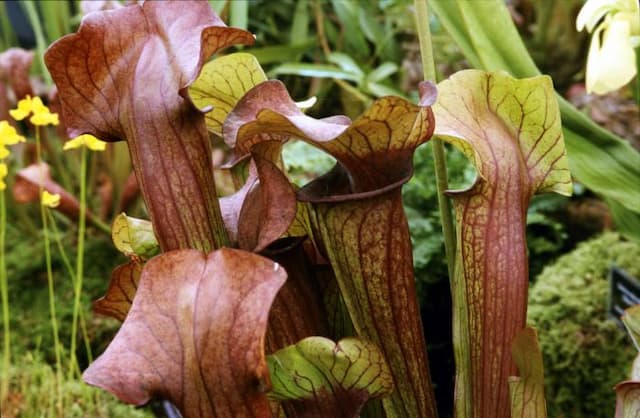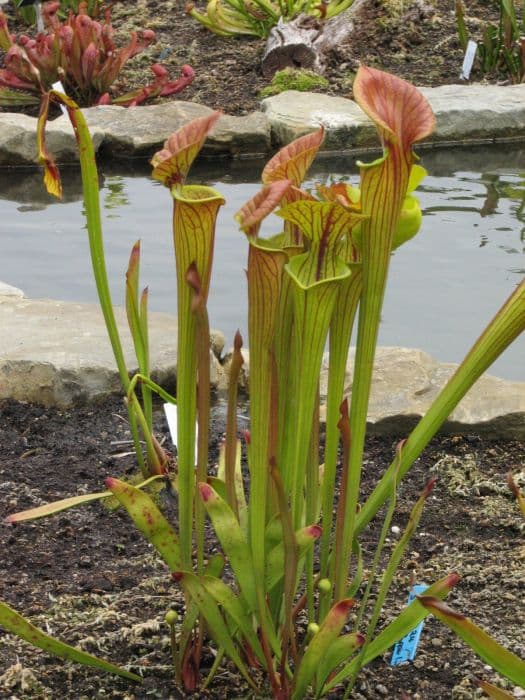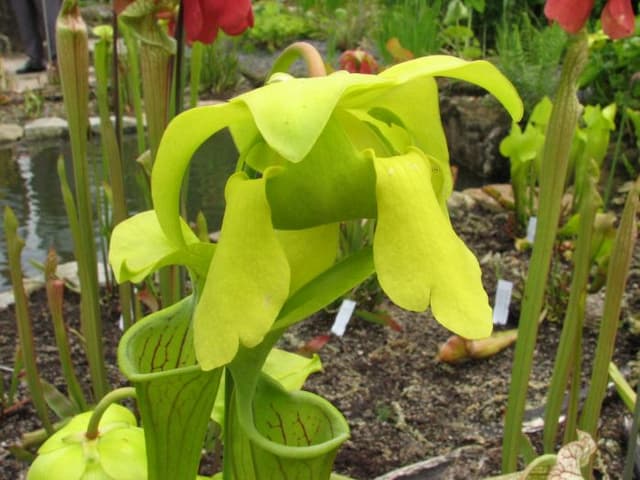Chelson’s Pitcher Plant Sarracenia × chelsonii

ABOUT
Sarracenia × chelsonii, commonly known as the Chelsonii Pitcher Plant, is a distinctive hybrid with a unique appearance that sets it apart in the plant world. This plant is characterized by its striking pitcher-shaped leaves that are designed to trap insects. These leaves are tubular structures that often exhibit a variety of colors, including shades of green, red, and purple, with veins that can be quite pronounced, adding to the visual interest of the plant. Some pitchers may be uniformly colored, while others feature a mottled pattern or distinct color gradients. At the top of each pitcher leaf is a hood-like structure that not only serves to lure prey but also provides shade, reducing the evaporation of the digestive fluids contained within the pitcher. The pitchers may have ruffled or smooth edges and are sometimes adorned with tiny hairs pointing downwards, which help to prevent the escape of trapped insects. In addition to its carnivorous leaves, the Chelsonii Pitcher Plant produces flowers. These flowers generally rise above the pitchers on tall stalks. They can be quite dramatic, with bold colors and an unusual shape that complements the overall exotic look of the plant. The overall growth habit of the Chelsonii Pitcher Plant tends to be clumping, with the pitchers rising up from a central rosette. This hybrid captures attention not only for its beauty but for its unique adaptations to its environment, showing off a captivating mix of form and function.
About this plant
 Names
NamesSynonyms
Chelson's Pitcher Plant, Hybrid Pitcher Plant
Common names
Sarracenia × chelsonii
 Toxicity
ToxicityTo humans
Sarracenia × chelsonii, also known as trumpet pitcher plant, is not commonly known to be toxic to humans. Ingesting parts of the plant is not advised as it may cause gastrointestinal discomfort due to its indigestible nature. However, there are no significant reports of poisoning or serious health effects from consumption by humans. If you suspect ingestion and experience adverse effects, seek medical attention.
To pets
The trumpet pitcher plant is generally not considered toxic to pets. While it is not advisable for pets to ingest plant material, as it could potentially cause mild gastrointestinal upset such as vomiting or diarrhea due to the plant's indigestible nature, there is no widespread evidence of serious toxicity or poisoning in pets resulting from ingestion of Sarracenia × chelsonii. If your pet does consume any part of the plant and shows symptoms of distress, it is best to consult with a veterinarian.
 Characteristics
CharacteristicsLife cycle
Perennials
Foliage type
Deciduous
Color of leaves
Varies
Flower color
Varies
Height
1-3 feet [30-91 cm]
Spread
1-2 feet [30-61 cm]
Plant type
Herb
Hardiness zones
5
Native area
Cultivar
Benefits
 General Benefits
General Benefits- Ornamental Value: Sarracenia × chelsonii, commonly known as the pitcher plant, is admired for its unique and striking pitcher-shaped leaves which add aesthetic appeal to gardens and landscapes.
- Insect Control: The pitcher plant is carnivorous, trapping and digesting insects, which can help reduce the population of unwanted pests naturally.
- Conservation Status: Being a hybrid, it can play a role in horticultural conservation efforts by providing an alternative to collecting wild specimens of endangered Sarracenia species.
- Education and Interest: The unusual insectivorous habit of this plant makes it an excellent educational tool for teaching about plant diversity, adaptation, and evolution.
- Ecosystem Support: By attracting and supporting a variety of insects and microorganisms within its pitchers, it helps support a micro-ecosystem and contributes to biodiversity.
- Water Management: The pitcher plant prefers moist environments and can be utilized in bog gardens or rain gardens to manage areas with excess water.
 Medical Properties
Medical PropertiesThis plant is not used for medical purposes.
 Air-purifying Qualities
Air-purifying QualitiesThis plant is not specifically known for air purifying qualities.
 Other Uses
Other Uses- Sarracenia × chelsonii, commonly known as pitcher plant, can be used as an educational tool in biology classes to demonstrate plant adaptations, carnivory in plants, and ecological interactions between insects and plants.
- The pitcher plant’s unique shape and vibrant coloring can be employed in art and photography projects, providing a natural subject that showcases the diversity of plant forms.
- Insect control in small-scale agriculture or gardens can occasionally be an unconventional use because pitcher plants trap and digest various insects, potentially reducing pest populations.
- Children's craft projects might use the distinct pitcher plant parts to create botanical collages or to inspire designs for fairy tale creatures due to its otherworldly appearance.
- Pitcher plants can be incorporated into water garden designs, where conditions allow, to add variety and to spark conversations around bog plants and their habitats.
- The plants may be used in terrariums or paludariums geared towards mimicking bog environments, where they can play a role in the contained ecosystem while being on display.
- Culinary experimentation, while not common due to the plant's carnivorous nature, might include using the pitcher plant in plating and presentation of adventurous gourmet dishes, although the plant itself is not consumed.
- During festive seasons, such as Halloween, pitcher plants can be integrated into decorations, taking advantage of their eerie look to enhance the spooky theme of an event or setting.
- As a natural oddity, it can serve as a point of interest in boutique hotels or businesses that wish to showcase exotic and unusual plants to attract clientele.
- Creative writing and storytelling might leverage the pitcher plant's unique predatory habits as inspiration for fictional plants or as symbolic elements within stories.
Interesting Facts
 Feng Shui
Feng ShuiThe Sarracenia, commonly known as the pitcher plant, is not typically used in Feng Shui practice.
 Zodiac Sign Compitability
Zodiac Sign CompitabilityThe pitcher plant is not used in astrology practice.
 Plant Symbolism
Plant Symbolism- Rarity: Sarracenia × chelsonii, commonly known as hybrid pitcher plants, are fairly uncommon and their unusual appearance can symbolize rarity or uniqueness.
- Adaptation: As a carnivorous plant, it has adapted to nutrient-poor environments by evolving the ability to trap insects. This can symbolize adaptability and resourcefulness.
- Mystery: The pitcher plant's unique method of capturing prey often fascinates people, symbolizing mystery and intrigue.
- Deception: With their attractive and deceptive traps, pitcher plants may symbolize deceit or illusion due to the way they lure their prey under false pretenses.
- Balance in Nature: These plants play a specific role in their ecosystems, so they can be seen as a symbol of the balance of nature and ecological interdependence.
 Water
WaterFor the Sarracenia × chelsonii, commonly known as hybrid pitcher plant, water generously to keep the soil consistently moist, never letting it dry out completely. Use distilled water, rainwater, or reverse osmosis water, and water the plant directly into the soil, avoiding the pitchers. During active growth in spring and summer, watering may be needed once or twice a week, providing about one to two gallons per week depending on temperature and humidity. Decrease watering in the dormant winter months but ensure the soil remains slightly moist.
 Light
LightThe hybrid pitcher plant thrives in full sun, receiving at least six hours of direct sunlight daily. The best spot for the plant is outdoors in a sunny, open area or in a south-facing window if grown indoors. The ample light helps to maximize the plant's color and promotes healthy growth, but avoid excessively hot, direct afternoon sun in very warm climates which can scorch the leaves.
 Temperature
TemperatureThe hybrid pitcher plant prefers a temperate range, with ideal temperatures between 70°F and 90°F during the growing season. They can tolerate a minimum temperature of around 32°F and a maximum of 100°F. To induce dormancy, it's beneficial to expose the plant to cooler temperatures, roughly between 32°F and 45°F, for a few months in winter.
 Pruning
PruningPrune the hybrid pitcher plant to remove any dead or dying pitchers and leaves, which will promote new growth and help prevent disease. The best time for pruning is during the early spring before new growth starts. Do this annually, or as needed throughout the growing season, to keep your plant healthy and well-shaped.
 Cleaning
CleaningAs needed
 Soil
SoilThe best soil mix for Chelson's Pitcher Plant, a hybrid of Sarracenia, is a combination of sphagnum peat moss and perlite or sand in a 2:1 ratio. This habitat mimics their natural boggy conditions and ensures good drainage. The soil pH should be acidic, ideally between 4.0 and 5.5.
 Repotting
RepottingChelson's Pitcher Plant should be repotted every 2 to 3 years to refresh the soil and provide room for growth. Spring, just before the growing season, is the best time to repot this carnivorous plant.
 Humidity & Misting
Humidity & MistingChelson's Pitcher Plant thrives in high humidity levels, ideally around 60-80%. These levels replicate the humid conditions found in their native bog habitats. However, they can adapt to slightly lower humidity if necessary.
 Suitable locations
Suitable locationsIndoor
Give bright light, keep moist, and ensure high humidity.
Outdoor
Full sun to partial shade, keep soil moist.
Hardiness zone
5-8 USDA
 Life cycle
Life cycleSarracenia × chelsonii, commonly known as Chelson’s Pitcher Plant, begins its life as a seed, which upon germination in wet and sunny conditions, sprouts into a seedling with small, ground-hugging leaves. As the seedling matures, it produces the characteristic pitcher-shaped leaves designed to trap insects, deriving nutrients especially in nutrient-poor soils. These pitchers are modified leaves that form a cavity filled with digestive fluid. The plant goes through vegetative growth, producing clumps of pitchers and non-carnivorous leaves, flowering annually, usually in spring, with unique, nodding flowers. After pollination, typically by bees or other insects, the flowers develop into seed pods, which split open when mature to release numerous tiny seeds. The plant enters a period of dormancy during the winter months, reducing metabolic activity until favorable growth conditions return in the spring.
 Propogation
PropogationPropogation time
Spring-Early Summer
The Sarracenia × chelsonii, commonly known as the Chelsonii Pitcher Plant, is best propagated by division. This method is popular because it is reliable and relatively straightforward. It should be done in late winter to early spring, just as the plant is coming out of dormancy. To propagate by division, carefully remove the plant from its pot and gently separate the rhizomes, ensuring that each division has at least one growth point. The divisions can then be potted into appropriate carnivorous plant soil and kept in conditions with high humidity until they establish and start producing new growth. Divisions should be watered with rainwater, distilled water, or reverse osmosis water, avoiding tap water due to potential mineral content that could harm the plant.









